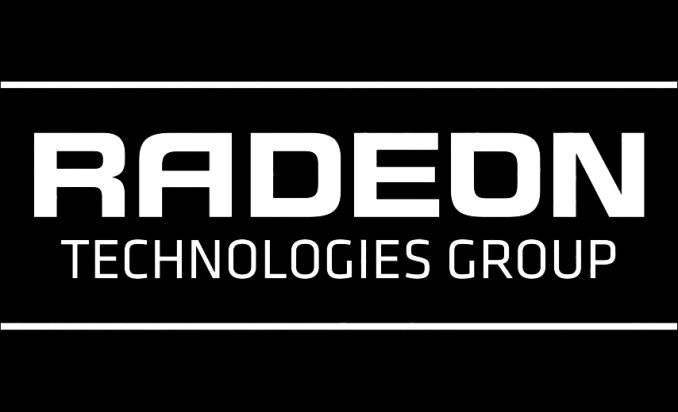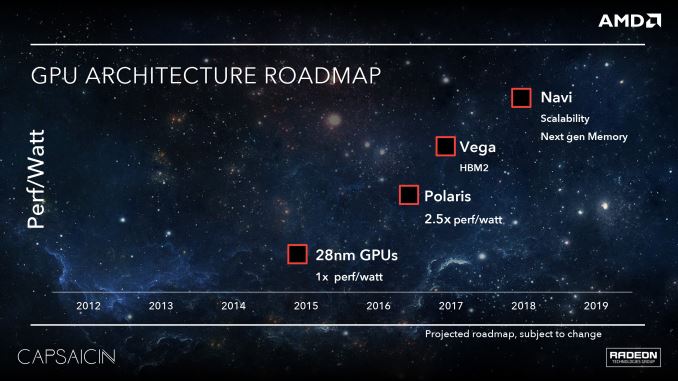AMD Unveils GPU Architecture Roadmap: After Polaris Comes Vega
by Ryan Smith on March 15, 2016 3:30 AM EST
Although AMD’s GDC 2016 “Capsaicin” event was primarily focused on game development – it is the Game Developers Conference, after all – AMD did spend a brief moment discussing their future GPU plans. For the first time in many years, AMD has published a GPU architecture roadmap.
Plotting perf/watt against the years, AMD’s roadmap unveils two new architectures: Vega, and Navi. Essentially everything there is to know about these architectures is in this slide – AMD is being tight-lipped regarding further details – but this map gives us some tantalizing new information to work with.
Vega is currently scheduled to come relatively quickly after Polaris. Depending on how literal you interpret this chart, the far left edge of the Vega box does fall into 2016, though obviously AMD intends to leave themselves some wiggle room here and not tie themselves down to specific dates. The fact that Vega comes this soon after Polaris is interesting; it seems hard to believe that it’s a direct successor to Polaris – I can’t see AMD replacing Polaris parts in less than a year – so this points to Vega being more of a cousin, and is where AMD’s naming system isn’t especially helpful in deciphering anything further.
With Polaris confirmed to use GDDR5, Vega is notable for being the first AMD architecture to use HBM2, and the first parts in general to use HBM tech since Fiji. I’m presuming these are higher-end GPUs to complement the Polaris GPUs (the smaller of which we know to be a low-power laptop design), which is where HBM would be more cost-effective, at least at current prices.
Meanwhile AMD has also confirmed the number of GPUs in the Vega stack and their names. We’ll be seeing a Vega 10 and a Vega 11. This follows Polaris GPU naming – which has finally been confirmed – with Polaris 10 and Polaris 11. I have also been told that Polaris 11 is the smaller of the Polaris GPUs, so at this point it’s reasonable to assume the same for Vega.
Finally, farther out towards 2018 is an architecture AMD is calling Navi. This one I suspect will attract the most attention (even if it’s the farthest out) due to the ambiguity of its features: “scalability” and “next gen memory”. Similar to how it’s hard to see Vega directly replacing Polaris, it’s hard to see Navi directly replacing Vega after only a year. This leaves Navi rife for speculation; I could very well see it being a Polaris replacement since we’ll be nearly 2 years past Polaris, or perhaps something to do with AMD’s APU plans. Either way I don’t expect that this will be the last time AMD teases it before finally launching it.

















54 Comments
View All Comments
RobATiOyP - Tuesday, March 15, 2016 - link
HBM1 was limitted to 4GiB (which would have seemed like a good first target a few years ago), that's one reason HBM2 is required already.asimov1979 - Tuesday, March 15, 2016 - link
I think Vega will be the true succesor of Fiji, while Polaris will have the rest of the stack.haukionkannel - Tuesday, March 15, 2016 - link
Most likely this. The Gddr5 is the cheapest available "highend" memory (low end ddr3...) and Gddr5+ will come too late. Also the HBM2 is coming too late, so that is why Vega goes to 2017.Interesting to see how much common Polaris and Vega have architectual. Are they the "same" with different memory architecture, or is Polaris tweaked 3xx series with smaller node and Vega tweaked Fiji with smaller node.
It would make sense, because the different memory can affect the chip design in larger scale.
Well end of the year or first half of 2017 will show.
Mat3 - Tuesday, March 15, 2016 - link
These marketing guys are way too optimistic about process shrinks in the near future.